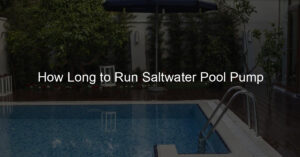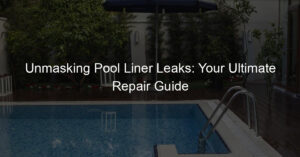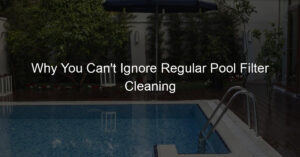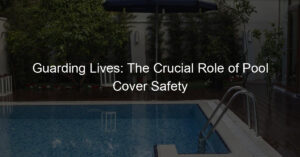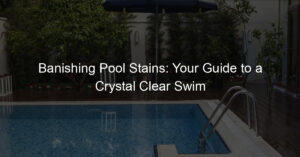Maintaining the perfect chemical balance in a swimming pool can be quite a challenging task. One essential aspect of pool chemistry that often gets overlooked is alkalinity. Alkalinity refers to the water’s ability to neutralize acids and is directly related to the pH levels. High alkalinity in your pool can cause issues with the overall water quality and even lead to damage to the pool surfaces and equipment.
If you’ve discovered that the alkalinity levels in your pool are too high, it’s essential to take the necessary steps to bring them back down to an appropriate range. Not only will this help maintain the comfort and safety of your swimming experience, but it also ensures the longevity of your pool and its components. In this article, we will guide you through the process of lowering alkalinity, providing tips, tricks, and everything you need to know about maintaining the perfect balance for your swimming pool.
First thing first:
What is pool alkalinity?
Pool alkalinity, often referred to as “total alkalinity,” is a measure of the water’s ability to neutralize acids. Think of it as a buffer that keeps the pool’s pH level from fluctuating drastically. When the alkalinity is balanced, it helps maintain stable pH levels, which is crucial for the comfort of swimmers and the longevity of pool equipment.
If the alkalinity is too low, pH levels can swing erratically, while high alkalinity can make it challenging to adjust pH. Monitoring and adjusting pool alkalinity is essential for maintaining clear, healthy pool water.
Key Takeaways
- Maintaining proper alkalinity in the pool preserves water quality, equipment, and surfaces.
- Timely measuring and monitoring of alkalinity levels help avoid imbalances
- Following the step-by-step process and addressing special situations is crucial for achieving the desired results
Understanding Alkalinity in Pools
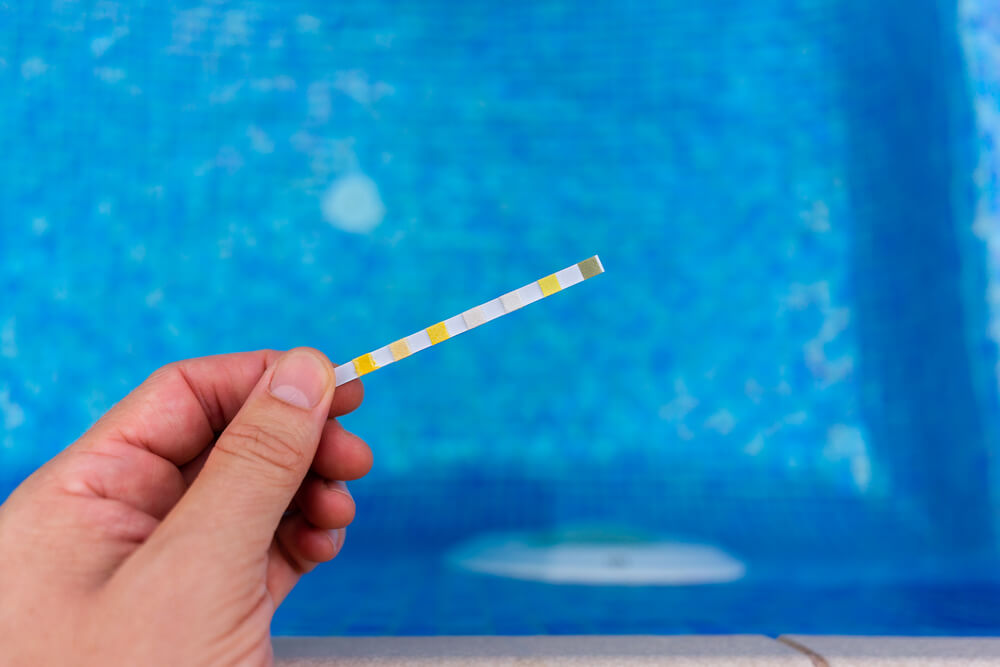
When I’m maintaining my swimming pool, one of the critical aspects I consider is the pool’s alkalinity levels. Alkalinity is crucial for pool water chemistry because it helps keep the pH levels stable. Balancing total alkalinity in my pool promotes healthy water, making it more comfortable for swimming, protects pool equipment from corrosion, and ensures the effectiveness of sanitizers.
Having the right pool alkalinity levels prevents rapid pH fluctuations. It acts as a buffer that absorbs sudden changes in the water’s pH. If the alkalinity is too low, I’ve found that the water can become corrosive, causing damage to the pool’s surface, equipment, and even my swimmer’s skin and eyes. Conversely, when the alkalinity is too high, it may lead to cloudy water, scaling, and reduced effectiveness of sanitizers.
To maintain my pool’s water chemistry, I keep the total alkalinity between 80 and 120 ppm (parts per million). If I need to address high alkalinity, I can follow these steps:
- Test the water: I regularly test the pool water using a test kit to check the total alkalinity and pH levels.
- Choose a reducer: To lower the alkalinity, I usually use muriatic acid or sodium bisulfate, which are readily available at pool supply stores.
- Turn off the pump: Before adding any chemicals, I turn off my pool pump to avoid circulating the water while adjusting the alkalinity.
- Distribute the reducer: I slowly pour the reducer into the pool water, distributing it evenly around the pool perimeter.
- Wait and retest: After waiting for a few hours, or as recommended by the reducer’s instructions, I retest my pool water to ensure my total alkalinity and pH levels are within the desired range.
By understanding how alkalinity works in my pool and addressing any imbalances, I can ensure a safe, comfortable, and enjoyable swimming experience for myself and my friends and family.
Importance of Alkalinity Balance
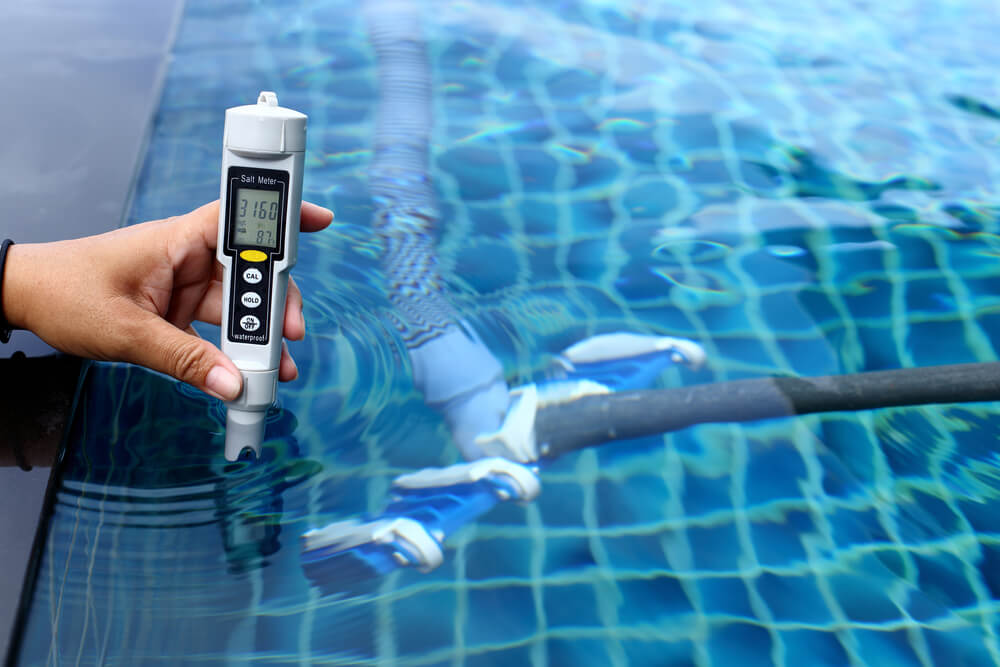
As a pool owner, I can’t stress enough the importance of maintaining the proper alkalinity balance in my pool water. When it comes to pool water chemistry, alkalinity is a crucial component that plays a big role in ensuring both the comfort of swimmers and the lifespan of pool equipment.
To help understand this, let me give you a brief insight into why alkalinity balance is so important. Alkalinity acts as a pH buffer, meaning it helps to stabilize and regulate pH levels in the water. If the alkalinity level is too high or too low, it can cause significant imbalances in the water chemistry, leading to various problems.
High total alkalinity can lead to high pH levels, causing cloudy water, scale formation on pool surfaces and equipment, and reduced effectiveness of sanitizers, resulting in poor water quality. On the other hand, low total alkalinity can also be troublesome, as it can lead to low pH levels. This can cause corrosion of metal parts, damage to pool surfaces, and even skin and eye irritation for swimmers.
In order to avoid these issues, it’s essential to regularly monitor and adjust the alkalinity levels in the pool. The chemicals used to manage alkalinity should be added with caution, as they have the potential to impact other aspects of water chemistry. To lower alkalinity, sodium bisulfate or muriatic acid is commonly used, while sodium bicarbonate or baking soda can be used to raise alkalinity levels.
Achieving the right balance in pool water chemistry can be a bit overwhelming, especially for new pool owners. However, understanding the importance of alkalinity and its relationship with pH, water chemistry, and overall pool health will make it easier to maintain crystal-clear water and avoid costly damage to equipment and surfaces.
Remember, maintaining the ideal alkalinity balance ensures that your pool is not only visually appealing but also comfortable for swimmers and kind to your equipment. Regularly testing and adjusting the chemical balance can save you time and money and ultimately lead to a more enjoyable swimming experience for everyone. Happy swimming!
How to Measure Alkalinity
When I want to measure the alkalinity of my pool, I begin by selecting the right testing kit. There are various options available in the market, like test strips or a water testing kit that uses reagents. Both types can help me determine the alkalinity level in my pool water.
For using test strips, I follow these simple steps:
- Dip the test strip into the pool water about 18 inches below the surface.
- Swirl the test strip around for a few seconds to ensure a thorough sample.
- Quickly pull the strip out of the water and give it a quick shake to remove any excess water.
- Wait for the stipulated time mentioned on the package for the strip color to change.
- Compare the resulting color against the color chart provided to determine the alkalinity in parts per million (ppm).
Alternatively, when I use a water testing kit with reagents, I follow the instructions mentioned in the kit, which usually involves:
- Collecting a water sample from my pool.
- Adding a specific number of drops of the reagent into the water sample.
- Observing any color change and comparing it to the color chart provided to determine the alkalinity in ppm.
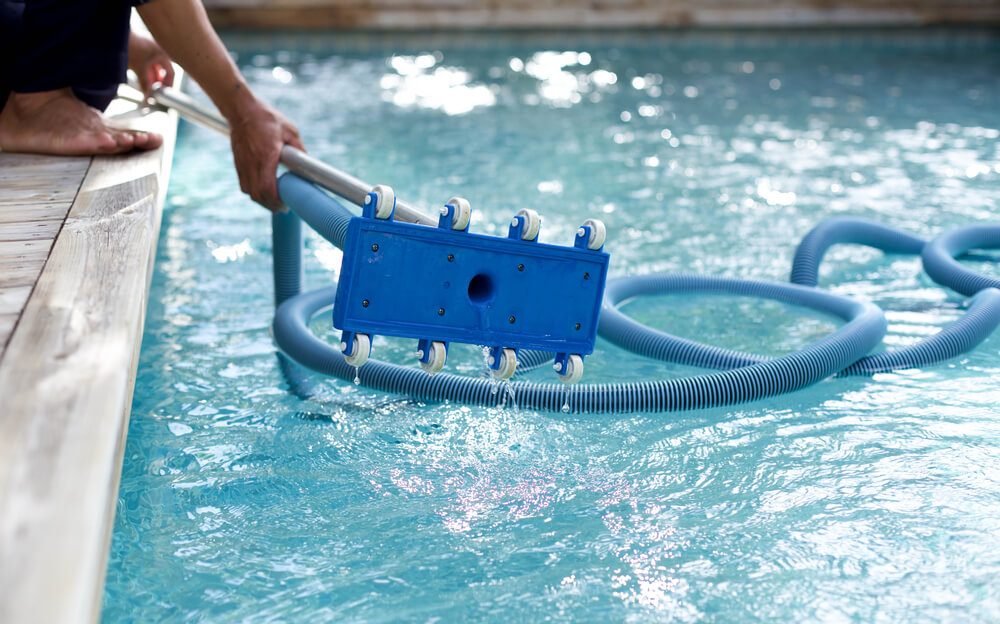
After measuring alkalinity, I often find it helpful to know how much chemical to add to my pool to achieve the right balance. For this, I rely on a pool calculator that assists me in determining the exact amount of chemicals needed. Online pool calculators are a quick and convenient option, as they usually only require me to input my pool’s specifications and current alkalinity reading. The calculator then provides me with the appropriate amount of chemicals to add.
Remember, regularly monitoring the water chemistry in your pool is essential. I always aim to measure my pool’s alkalinity at least once a week using test kits or test strips. Knowing the alkalinity level helps me maintain a well-balanced and healthy swimming environment.
Signs of Alkalinity Imbalance
I’ve noticed that when pool water has an imbalance of alkalinity, several signs can indicate this issue. The first sign that caught my attention was itchy skin. Swimming in a pool with imbalanced alkalinity may cause this discomfort. In addition, irritated eyes can be an issue that swimmers may face due to the water’s chemical imbalance.
Another sign that indicates an alkalinity problem is the appearance of the water. The pool water might turn cloudy or even murky, making it difficult to see through. This poor visibility can be troubling, as clarity is essential for enjoying a refreshing swim.
Along with the water’s appearance, I observed that scaling and calcium scaling could occur with high alkalinity. These are deposits of calcium that form on pool surfaces, equipment, and even in the water itself. They can be quite difficult to remove and may result from high calcium levels in the pool.
Lastly, I’ve learned that imbalanced alkalinity can also promote algae growth. High alkalinity creates an environment where algae can thrive, making it essential to maintain the correct balance to prevent these unwanted invaders.
In conclusion, paying attention to these signs of alkalinity imbalance, such as itchy skin, irritated eyes, cloudy water, scaling, and algae growth, can help maintain a clean, enjoyable pool experience.
Materials Needed for Lowering Alkalinity
When I need to lower the alkalinity in my pool, having the right materials on hand is essential. Let me share with you what I typically use:
1. Chemicals: There are a few options to choose from when it comes to chemicals that can lower alkalinity. Here are the ones I’ve tried and found effective:
- Muriatic Acid: This is a strong acid that reacts with the pool water to lower alkalinity. It’s important to handle it with care, as it can be dangerous if not used correctly.
- Sodium Bisulfate (Dry Acid): This is a granular form of acid that works similarly to muriatic acid. I find it a little easier to manage, as it’s less hazardous than liquid acids.
- Baking Soda: Although not as potent as other chemicals, baking soda can be used to make small adjustments to the alkalinity. However, keep in mind that it can also raise the pH levels in the water.
2. Protective Gear: Safety is paramount when handling chemicals, so I always make sure to have the following items on hand:
- Goggles: It’s essential to protect my eyes from any splashes or accidental contact with the chemicals.
- Gloves: Wearing gloves helps to prevent any skin irritation or burns that may occur while handling acids.
3. Test Kit: In order to check the alkalinity level of my pool, I use a test kit. It’s crucial to get accurate readings, so I can make the necessary adjustments to the water’s chemical balance.
4. Measuring Cup or Container: To ensure that I dose the chemicals accurately, I use a measuring cup or a properly marked container to measure the amount needed.
5. Water Balance: It’s essential to keep an eye on the overall water balance in my pool. When using chemicals like muriatic acid or sodium bisulfate, I must be cautious, as these may affect other parameters such as pH, calcium hardness, and chlorine levels. That’s why having a supply of pH increasers, like soda ash and chlorine tablets, is beneficial to maintain a healthy pool.
By having these materials readily available, I can effectively lower the alkalinity levels in my pool and keep it safe and enjoyable for everyone.
Step-By-Step Process to Lower Alkalinity
First, I tested the pool water to determine the current alkalinity level. This helps me know how much I need to reduce it. I aim for an alkalinity level of 80-120 ppm (parts per million).
Next, I choose an appropriate acid, such as muriatic acid or dry acid (sodium bisulfate), to lower the alkalinity. I carefully follow the manufacturer’s recommended dosage and instructions for adding it to the pool, as too much acid can cause damage to the pool surfaces and equipment.
To add the acid, I take the following steps:
- Turn off the pool pump and let the water become still.
- Pour the pre-determined amount of acid into a bucket of water and mix it well.
- Slowly pour the mixture around the deep end of the pool, avoiding any contact with the pool walls or floor.
- Allow the acid to work for about 30 minutes.
After 30 minutes, I turn the pool pump back on to circulate the water. I then tested the pool water again to check the new alkalinity level. It’s normal for the pH level to drop when lowering alkalinity, so I also test the pH level and adjust it to the ideal range of 7.4-7.6 if necessary.
In some cases, aeration helps increase the pH level without affecting the alkalinity. I can aerate the water by turning on the pool’s water features, like fountains, or aiming the return jets towards the surface to create water movement.
I continue to test the pool water and make adjustments as needed until the desired alkalinity and pH levels are reached. Lastly, I maintain a regular schedule to check the pool water’s balance, ensuring the alkalinity remains within the ideal range for a healthy swimming environment.
Dealing with Special Situations
Sometimes, lowering the alkalinity in your pool can be more challenging due to various special situations. Let me share some tips on how to tackle these issues.
If you’re dealing with cloudy pool water, first ensure that your pool’s pH levels, free chlorine, and calcium levels are within the recommended range. Clogged filters can also contribute to cloudiness, so make sure to clean or replace them as needed.
In the case of rain, it can dilute your pool water, affecting its chemical balance. After heavy rainfall, it’s best to test your pool’s alkalinity and adjust it accordingly.
Algae growth can be combated by maintaining proper free chlorine levels and circulation. If an algae outbreak does occur, use an algaecide and brush your pool surfaces to disrupt the growth. Then, vacuum up the remaining dead algae.
To prevent corrosion, always maintain the appropriate levels of pH, alkalinity, and calcium hardness. If your pool has metal components, consider using a corrosion inhibitor.
When faced with clogged filters, you should backwash and clean them regularly to ensure proper water flow and filtration. If the filters are too old or worn out to function properly, it’s best to replace them.
Contaminants can enter the pool in various ways, such as through swimmers and the environment. To minimize their impact, use a pool skimmer, vacuum, and maintain an appropriate chlorine level.
If your pool has water features or is a hot tub, you may need to monitor and adjust the chemical balance more frequently due to increased water agitation.
Finally, if you have concerns about your water source causing high alkalinity, consider investing in a water softener or utilizing an alternative water source to fill your pool. Dealing with high calcium levels will also help prevent scale formation and cloudy water.
By considering these special situations, you can be better equipped to maintain proper alkalinity and overall pool health. Remember to regularly test your pool water and follow best practices to ensure a safe and enjoyable swimming experience.
Maintaining Alkalinity Balance
In my experience with pool maintenance, I have found it essential to maintain the right alkalinity balance. If your pool’s alkalinity is too high, it can decrease the effectiveness of chlorine and make it difficult to maintain a clean pool. Thankfully, there are a few steps you can take to lower the alkalinity in your pool.
First, I usually check my pool’s chemical levels with a test kit to determine its current alkalinity and pH levels. When I find that the alkalinity and pH levels are too high, I add a pH reducer, such as sodium bisulfate or muriatic acid, to lower the alkalinity. Make sure to follow the manufacturer’s instructions on how much to add, and always add the chemicals in the deep end of the pool with the pool pump running.
It’s also essential to keep my pool clean to maintain the proper alkalinity balance. I regularly clean the filter and skimmer baskets to ensure the pool pump is working efficiently. A clean filter helps balance the pool water’s chemistry and prevent algae growth.
I’ve learned that adding sodium carbonate can raise pool alkalinity if it becomes too low. However, in doing so, the pH level might also increase. It’s essential to adjust the alkaline levels carefully and never add too much at once. Add a little at a time and retest the water to achieve the ideal alkalinity range, which is typically between 80-120 ppm for most pools.
Lastly, I keep an eye on my pool’s chlorine levels. If the water’s alkalinity is too high, it can decrease the effectiveness of chlorine, leading to a dirty pool and requiring more pool shock to keep it clean. By maintaining the proper alkalinity balance, I ensure that the chlorine works effectively and my pool stays clean.
That’s what I’ve found helpful in maintaining the alkalinity balance in my pool. With consistent pool care, it’s easier to enjoy a clean and safe pool environment.
Common Mistakes and How to Avoid Them
When I first started maintaining my pool, I made a few mistakes that many pool owners make when trying to lower alkalinity. High total alkalinity can cause problems like cloudy water and scale formation, while low total alkalinity can lead to etching and unstable pH levels. To help you avoid these common errors, here are some friendly tips I’ve learned along the way.
One common mistake is not testing the water correctly. It’s essential to understand the pH scale and regularly test your pool’s water. This way, you’ll know if you’re dealing with high or low total alkalinity and can take appropriate action. To avoid this issue:
- Use a reliable and accurate test kit.
- Test pool water regularly, ideally once a week.
- Keep a record of your test results for reference.
Another mistake is using the wrong chemicals or a poor method to lower alkalinity. Many people don’t realize that alkaline water can be lowered using chemicals like borax or muriatic acid. Using the wrong chemical can have unintended consequences. For instance, bromine can lower pH but not affect alkalinity, so it’s important to know and use the right chemical for the desired effect. To avoid this problem:
- Make sure you’re using the right chemical for your situation.
- Follow the manufacturer’s instructions to avoid applying too much or too little.
Calcium hardness also plays a role in your pool’s alkalinity; it can help stabilize and balance the water. However, adding too much calcium can lead to scaling and high total alkalinity. Here’s a quick tip to avoid this issue:
- Regularly test your pool’s calcium hardness and maintain the recommended levels.
Lastly, a common but easy-to-avoid mistake is not adjusting your pool’s alkalinity gradually. Lowering alkalinity too quickly can cause the pH to become unstable and lead to other issues, like etching on the pool surfaces. To avoid this problem:
- Lower alkalinity in smaller increments, retesting the water after each adjustment.
By keeping these tips in mind and learning from my experiences, I hope you can maintain a balanced pool environment and enjoy a clear, sparkling pool for years to come.
Conclusion

Pool maintenance can be a challenging task, but managing alkalinity levels is essential for the health of your pool. I’ve found that regularly testing the water and being proactive with adjustments can help maintain proper balance and prevent uncomfortable swimming conditions.
In my experience, lowering alkalinity in a pool often involves using an acid, like muriatic acid or dry acid. Remember to always add acid to a bucket of water before dispersing it evenly around the pool. Don’t forget to run the pool pump for several hours after adding any chemicals to ensure proper circulation and distribution.
Additionally, it’s crucial to monitor and adjust the pH levels after reducing alkalinity. Maintaining the proper pH range of 7.4-7.6 will help minimize potential issues, such as corrosion or scale formation. Don’t hesitate to seek professional help if you’re unsure about any aspect of pool water management or if you encounter stubborn imbalances.
I hope this information helps you as much as it has helped me in maintaining my pool. Remember, with consistency and attention, you can enjoy a crystal-clear swimming experience all season long. Happy swimming!
Frequently Asked Questions
What’s the best method to reduce pool alkalinity?
I believe the most effective way to lower pool alkalinity is by adding muriatic acid or a dry acid like sodium bisulfate. Always start with small amounts of the product and retest the water after a few hours. Keep in mind that the process might take some time, so patience is key.
How can I balance pH while lowering alkalinity?
Lowering the alkalinity will often lower the pH as well. However, to specifically target alkalinity, try adding the acid along the pool perimeter, and turn off the circulation pump for at least 20-30 minutes. This allows the acid to work on the alkalinity before it affects the pH.
Can baking soda be used to decrease alkalinity in the pool?
Actually, baking soda is used to increase alkalinity in pools. To lower alkalinity, you should use muriatic acid or a similar product instead. Baking soda is useful when you need to raise the alkalinity levels and stabilize the pH in your pool.
What are safe ways to use muriatic acid for pool alkalinity?
Safety always comes first when handling hazardous chemicals like muriatic acid. I recommend wearing protective equipment, like gloves and safety goggles. When adding the acid, pour it slowly and directly into the water along the perimeter of the pool. This helps distribute the acid evenly, reducing the chance of stains and corrosion.
Do pH decreasers also reduce alkalinity in pools?
Yes, pH decreasers can lower the alkalinity in pools, as they typically contain acids such as muriatic acid or sodium bisulfate. However, remember that lowering pH and alkalinity often go hand in hand, so be cautious not to treat both separately at the same time.
How can I calculate the correct amount of chemicals needed to lower pool alkalinity?
An important first step is to test your pool’s alkalinity level. Once you know the current level and the desired level, you can use online calculators or specific product instructions to determine the correct amount of the needed chemical. Remember, it’s always best to begin with a small amount, test the water, and adjust as needed.



